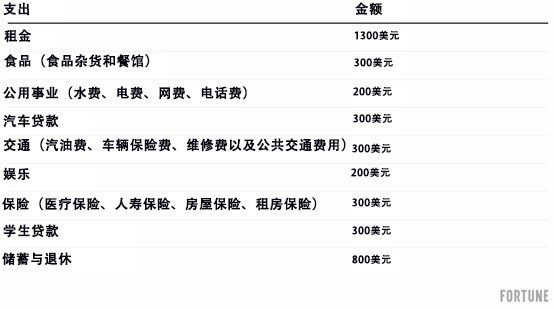
从牛油果吐司的兴起,到健身房的消亡,再到布餐巾的终结,千禧一代被认为是造成诸多社会混乱的罪魁祸首。但根据Nerdwallet在2023年进行的一项民意调查,有一领域他们并没有破坏:预算规划。
Nerdwallet发现,超过2.56亿美国人在他们的月度规划中采用了某种形式的预算策略。高达83%的千禧一代坚持每月编制预算,而婴儿潮一代和X世代的这一比例分别为67%和74%。
Armstrong, Fleming & Moore, Inc.负责人、注册理财规划师瑞恩·弗莱明(Ryan Fleming)表示:“预算一词常被视为贬义词,或带有某种负面含义。因此,我们倾向于将其称为‘支出计划’。不论你如何称呼它,关键在于掌握收入状况,并清楚资金流入和流出情况。”
制定预算并严格遵守是任何希望财务生活井然有序的人的首要任务。新年是下定决心和重启新篇章的时节,因此,这是审视现有预算计划的好时机,或是如果你之前从未制定过预算,这也是开始制定新预算的好时机。
如何编制预算:五大预算策略
弗莱明表示,制定预算并不复杂。只需了解你的所有支出和收入来源,这样,你就能在每一美元有可能被随意挥霍或让你陷入困境之前,为其分配好明确的用途。你可以将这一过程想象成与金钱进行对话:“你要负责支付房租,你要购买食品杂货,还有你——没错,就是你,排在后面的那位——你要承担起为我积累储蓄的任务。”
也就是说,存在多种多样的预算策略可供选择。让我们回顾一下最常见的五种预算编制方法,并探讨它们最适合哪类人群。

1. 50-30-20预算
50-30-20预算是一种预算编制公式,为特定类别分配一定比例的收入:
• 50%用于需求,如住房、食品、交通、保险和最低限度的债务偿还。
• 30%用于愿望,比如订阅服务、电影票、音乐会和旅行。
• 20%用于储蓄,包括应急基金、退休储蓄和额外的债务偿还。
这一规则为人们如何储蓄与消费提供了极为实用的基本指导。弗莱明建议那些正寻求新起点的人群采用这种预算策略——比如初次着手制定预算的年轻人,或是刚刚结束一段关系、作为单身人士其财务状况可能发生变化的人。
Bull Oak Capital的创始人兼投资组合经理瑞安·A·休斯(Ryan A. Hughes)提醒大家在某些情况下不要采用这种预算法。“在住房成本高昂的环境下,尤其是在湾区、南加州、纽约和其他高消费的城市地区,采用这种预算法可能会颇具挑战性。你的抵押贷款或租金很容易超过税后收入的50%。”
休斯补充道,尽管这种做法并不值得推荐,但有些家庭会通过压缩30%愿望支出的比例来抵消较高的住房成本。
2. 零基预算
零基预算指的是将每一笔收入都分配到支出以及诸如储蓄和债务偿还等财务目标上。将所有收入分配到特定类别的最终结果是,收入减去支出后余额为零,因此得名。
这是我个人使用的方法。我们会将当月所获得的全部收入用于下个月的预算——因为这些资金在编制预算和支出之前就已到账,因此无需猜测。当下个月到来时,我们确切地知道每个预算类别的可支出金额,而且如有需要,还能通过重新分配资金来实现灵活调整。
对于那些收入不稳定的人来说,这种提前一个月制定计划的方法是个不错的选择,因为这样一来,你所动用的始终都是银行账户里已经到账的资金。让我们来看一个真实的例子。如果一个没有受抚养人的单身人士每月收入为4000美元,那么包括储蓄和债务在内的总支出也应为4000美元。大致的预算如下:

请记住,这只是预算细目,实际生活中各项费用会因居住地的不同而存在显著差异。对于已婚、需要承担子女抚养费用和/或赡养父母经济责任的人来说,其预算分配情况也会有很大不同。
3. 信封预算
信封系统是戴夫·拉姆齐(Dave Ramsey)推广的一种预算方法,适用于那些希望偿还债务的人群。这一以现金管理为核心的策略要求你每月将特定金额的现金分别装入不同的实体信封中,每个信封对应一个预算类别。这些信封里的现金必须专款专用,不能挪作他用。一旦某个信封中的现金用完,就表示该预算类别下的消费已达到限额,需停止该类别的额外消费。
采用这种方法编制预算旨在防止超支现象的发生。相较于现金使用受到限制,刷借记卡或信用卡很容易超出限额。因此,这种方法要求使用者具备良好的预见性和高度的自律性。
当然,这种方法也有其弊端。总部位于波士顿的员工财务健康平台Origin的咨询主管、注册理财规划师大卫·布莱洛克(David Blaylock)表示:“随着我们的社会日益趋向于无现金交易,挑战在于难以将该方法付诸实践。”此外,现金容易丢失或被盗,而且在建立个人信用方面并无助益。
4. 首先支付自己预算
假设你收支平衡,但在满足基本生活需求与即时欲望上的开销过大,以至于难以为未来储蓄。如果是这种情况,那么,“首先支付自己”的预算方法或许能为你提供一种新思路。
首先支付自己是指每月从收入中一次性或按一定比例划出一部分资金,用于储蓄和投资。这样做能够确保你为未来生活做好准备,并养成储蓄和投资的习惯。由于你先支付自己,然后再将剩余资金用于其他支出,你可能会发现这种方法有助于你更快地积累储蓄。这种方法有时被Afford Anything的保拉·潘特(Paula Pant)称为“反预算”策略。
5. 基于价值观的预算
如果你的年度关键词是“意向性”,那么你可能会发现基于价值观的预算规划与你的目标相契合。有时我们很容易心血来潮,让金钱从指缝中溜走,事后回想起来却会因所购之物而感到内疚或不满。
应对这种不满情绪的方法就是制定基于价值观的预算。这种预算方式与百分比和程序的关系不大,更多的是要确定自己的消费模式,并根据自己的价值观做出相应的调整。例如,你可能会重视外出就餐和新体验、为有价值的事业捐款或支付舞蹈课程的费用。
首先列出你所珍视的事物。然后为每个类别分配资金,以确保相关资金能够支持你的价值观。这种预算方式能带来更多的满足感,并让你思维清晰,从而有助于避免不必要的开支。
应避免的预算错误
正如有许多不同的预算编制方法可以尝试一样,预算编制过程中也伴随着一些容易踏入的误区。应当定期修改预算,尤其是在诸如结婚、生子、离婚、迁居或失业等重大生活变化期间。
在努力养成新预算习惯的过程中,你应该注意以下几种潜在的误区:
• 未对所有支出做好规划。每月相同的固定支出可能很容易规划,但在开始记录日常开销之前,要估算诸如外出就餐或夜晚娱乐之类的可自由支配支出就颇具挑战性了。说到这一点......
• 不记录支出。如果你制定了预算,却不记录支出,你如何知道自己是否真正遵循了预算规划呢?不妨考虑注册像“You Need a Budget”(YNAB)或“Rocket Money”的预算应用程序,以此来对自己的财务行为负责。
• 不修改预算。当编制预算并记录支出一段时间后,你应该审视一下结果,并在必要时调整行为。你是否发现自己在外出就餐上的开销超出了计划?你是否失去了一种收入来源?面对这些“偏离计划”的时刻,切勿气馁。相反,要将这些时刻视为调整的契机(为未来做好准备),以确保自己始终沿着正确的财务轨道前行。
• 因为收入不稳定而放弃预算编制。如果你是自由职业者、零工人员或从事佣金制工作,你的月收入可能每个月都有所不同。这可能会给预算编制带来挑战,但这并不意味着无法编制预算。像50-30-20这样的预算方法可能很适合你,这样一来,无论你的收入如何,都有百分比作为指导。
• 不将资金挪作他用。即使使用信封系统,如果某一预算类别的支出达到上限,需要进行调整,你也可以从其他预算类别中调配资金。例如,如果你的汽油费已达到本月限额,但突发紧急情况需要出行,你可以随时从娱乐信封中调配资金来支付这些费用。
要点
制定预算的过程就如同寻找一条合身的牛仔裤——可能需要经过反复试验,但一旦找到最适合自己的那条,你就会好奇在没有它之前的日子你是如何度过的。你可以尝试这些不同的预算编制方法,看看哪种与你的需求和生活方式最为契合,但最好的方法是那种你能坚持并经常使用的。
请务必根据需要更新预算,并持续跟踪你的财务状况和未来走向。未来的你(以及你的钱包)会感谢你的。(财富中文网)
梅勒妮·洛克特(Melanie Lockert)对本文亦有贡献。
译者:中慧言-王芳
从牛油果吐司的兴起,到健身房的消亡,再到布餐巾的终结,千禧一代被认为是造成诸多社会混乱的罪魁祸首。但根据Nerdwallet在2023年进行的一项民意调查,有一领域他们并没有破坏:预算规划。
Nerdwallet发现,超过2.56亿美国人在他们的月度规划中采用了某种形式的预算策略。高达83%的千禧一代坚持每月编制预算,而婴儿潮一代和X世代的这一比例分别为67%和74%。
Armstrong, Fleming & Moore, Inc.负责人、注册理财规划师瑞恩·弗莱明(Ryan Fleming)表示:“预算一词常被视为贬义词,或带有某种负面含义。因此,我们倾向于将其称为‘支出计划’。不论你如何称呼它,关键在于掌握收入状况,并清楚资金流入和流出情况。”
制定预算并严格遵守是任何希望财务生活井然有序的人的首要任务。新年是下定决心和重启新篇章的时节,因此,这是审视现有预算计划的好时机,或是如果你之前从未制定过预算,这也是开始制定新预算的好时机。
如何编制预算:五大预算策略
弗莱明表示,制定预算并不复杂。只需了解你的所有支出和收入来源,这样,你就能在每一美元有可能被随意挥霍或让你陷入困境之前,为其分配好明确的用途。你可以将这一过程想象成与金钱进行对话:“你要负责支付房租,你要购买食品杂货,还有你——没错,就是你,排在后面的那位——你要承担起为我积累储蓄的任务。”
也就是说,存在多种多样的预算策略可供选择。让我们回顾一下最常见的五种预算编制方法,并探讨它们最适合哪类人群。
1. 50-30-20预算
50-30-20预算是一种预算编制公式,为特定类别分配一定比例的收入:
• 50%用于需求,如住房、食品、交通、保险和最低限度的债务偿还。
• 30%用于愿望,比如订阅服务、电影票、音乐会和旅行。
• 20%用于储蓄,包括应急基金、退休储蓄和额外的债务偿还。
这一规则为人们如何储蓄与消费提供了极为实用的基本指导。弗莱明建议那些正寻求新起点的人群采用这种预算策略——比如初次着手制定预算的年轻人,或是刚刚结束一段关系、作为单身人士其财务状况可能发生变化的人。
Bull Oak Capital的创始人兼投资组合经理瑞安·A·休斯(Ryan A. Hughes)提醒大家在某些情况下不要采用这种预算法。“在住房成本高昂的环境下,尤其是在湾区、南加州、纽约和其他高消费的城市地区,采用这种预算法可能会颇具挑战性。你的抵押贷款或租金很容易超过税后收入的50%。”
休斯补充道,尽管这种做法并不值得推荐,但有些家庭会通过压缩30%愿望支出的比例来抵消较高的住房成本。
2. 零基预算
零基预算指的是将每一笔收入都分配到支出以及诸如储蓄和债务偿还等财务目标上。将所有收入分配到特定类别的最终结果是,收入减去支出后余额为零,因此得名。
这是我个人使用的方法。我们会将当月所获得的全部收入用于下个月的预算——因为这些资金在编制预算和支出之前就已到账,因此无需猜测。当下个月到来时,我们确切地知道每个预算类别的可支出金额,而且如有需要,还能通过重新分配资金来实现灵活调整。
对于那些收入不稳定的人来说,这种提前一个月制定计划的方法是个不错的选择,因为这样一来,你所动用的始终都是银行账户里已经到账的资金。让我们来看一个真实的例子。如果一个没有受抚养人的单身人士每月收入为4000美元,那么包括储蓄和债务在内的总支出也应为4000美元。大致的预算如下:
请记住,这只是预算细目,实际生活中各项费用会因居住地的不同而存在显著差异。对于已婚、需要承担子女抚养费用和/或赡养父母经济责任的人来说,其预算分配情况也会有很大不同。
3. 信封预算
信封系统是戴夫·拉姆齐(Dave Ramsey)推广的一种预算方法,适用于那些希望偿还债务的人群。这一以现金管理为核心的策略要求你每月将特定金额的现金分别装入不同的实体信封中,每个信封对应一个预算类别。这些信封里的现金必须专款专用,不能挪作他用。一旦某个信封中的现金用完,就表示该预算类别下的消费已达到限额,需停止该类别的额外消费。
采用这种方法编制预算旨在防止超支现象的发生。相较于现金使用受到限制,刷借记卡或信用卡很容易超出限额。因此,这种方法要求使用者具备良好的预见性和高度的自律性。
当然,这种方法也有其弊端。总部位于波士顿的员工财务健康平台Origin的咨询主管、注册理财规划师大卫·布莱洛克(David Blaylock)表示:“随着我们的社会日益趋向于无现金交易,挑战在于难以将该方法付诸实践。”此外,现金容易丢失或被盗,而且在建立个人信用方面并无助益。
4. 首先支付自己预算
假设你收支平衡,但在满足基本生活需求与即时欲望上的开销过大,以至于难以为未来储蓄。如果是这种情况,那么,“首先支付自己”的预算方法或许能为你提供一种新思路。
首先支付自己是指每月从收入中一次性或按一定比例划出一部分资金,用于储蓄和投资。这样做能够确保你为未来生活做好准备,并养成储蓄和投资的习惯。由于你先支付自己,然后再将剩余资金用于其他支出,你可能会发现这种方法有助于你更快地积累储蓄。这种方法有时被Afford Anything的保拉·潘特(Paula Pant)称为“反预算”策略。
5. 基于价值观的预算
如果你的年度关键词是“意向性”,那么你可能会发现基于价值观的预算规划与你的目标相契合。有时我们很容易心血来潮,让金钱从指缝中溜走,事后回想起来却会因所购之物而感到内疚或不满。
应对这种不满情绪的方法就是制定基于价值观的预算。这种预算方式与百分比和程序的关系不大,更多的是要确定自己的消费模式,并根据自己的价值观做出相应的调整。例如,你可能会重视外出就餐和新体验、为有价值的事业捐款或支付舞蹈课程的费用。
首先列出你所珍视的事物。然后为每个类别分配资金,以确保相关资金能够支持你的价值观。这种预算方式能带来更多的满足感,并让你思维清晰,从而有助于避免不必要的开支。
应避免的预算错误
正如有许多不同的预算编制方法可以尝试一样,预算编制过程中也伴随着一些容易踏入的误区。应当定期修改预算,尤其是在诸如结婚、生子、离婚、迁居或失业等重大生活变化期间。
在努力养成新预算习惯的过程中,你应该注意以下几种潜在的误区:
• 未对所有支出做好规划。每月相同的固定支出可能很容易规划,但在开始记录日常开销之前,要估算诸如外出就餐或夜晚娱乐之类的可自由支配支出就颇具挑战性了。说到这一点......
• 不记录支出。如果你制定了预算,却不记录支出,你如何知道自己是否真正遵循了预算规划呢?不妨考虑注册像“You Need a Budget”(YNAB)或“Rocket Money”的预算应用程序,以此来对自己的财务行为负责。
• 不修改预算。当编制预算并记录支出一段时间后,你应该审视一下结果,并在必要时调整行为。你是否发现自己在外出就餐上的开销超出了计划?你是否失去了一种收入来源?面对这些“偏离计划”的时刻,切勿气馁。相反,要将这些时刻视为调整的契机(为未来做好准备),以确保自己始终沿着正确的财务轨道前行。
• 因为收入不稳定而放弃预算编制。如果你是自由职业者、零工人员或从事佣金制工作,你的月收入可能每个月都有所不同。这可能会给预算编制带来挑战,但这并不意味着无法编制预算。像50-30-20这样的预算方法可能很适合你,这样一来,无论你的收入如何,都有百分比作为指导。
• 不将资金挪作他用。即使使用信封系统,如果某一预算类别的支出达到上限,需要进行调整,你也可以从其他预算类别中调配资金。例如,如果你的汽油费已达到本月限额,但突发紧急情况需要出行,你可以随时从娱乐信封中调配资金来支付这些费用。
要点
制定预算的过程就如同寻找一条合身的牛仔裤——可能需要经过反复试验,但一旦找到最适合自己的那条,你就会好奇在没有它之前的日子你是如何度过的。你可以尝试这些不同的预算编制方法,看看哪种与你的需求和生活方式最为契合,但最好的方法是那种你能坚持并经常使用的。
请务必根据需要更新预算,并持续跟踪你的财务状况和未来走向。未来的你(以及你的钱包)会感谢你的。(财富中文网)
梅勒妮·洛克特(Melanie Lockert)对本文亦有贡献。
译者:中慧言-王芳
From the rise of avocado toast, to the death of gyms and the end of cloth napkins, Millennials have been blamed for an eccentric variety of social disruptions. But according to a 2023 Nerdwallet poll, there’s one thing they haven’t ruined: budgeting.
Nerdwallet found that over 256 million Americans employ some form of budgeting in their monthly planning. A whopping 83% of millennials adhere to a monthly budget, compared to just 67% of boomers and 74% of Gen Xers.
“Budgeting is often thought of as a bad word or has some negative connotation,” says Ryan Fleming, CFP, principal at Armstrong, Fleming & Moore, Inc. “So we like to call it a ‘spending plan.’ Whatever you call it, it’s about knowing your income and understanding the inflows and outflows of your money.”
Making a budget—and sticking to it—is job one for anyone who wants a well-ordered financial life. The new year is a season of resolutions and fresh starts, and that makes it a great time to review your existing budget plan or get started with a new budget if it’s something you’ve not done before.
How to budget: Top 5 budget strategies
Making a budget shouldn’t be complicated, says Fleming. It’s as simple as understanding all of your expenses and sources of income, so that you can give every dollar a job before it has a chance to wander off and get into trouble. Think of it as telling your money: “You’re going to pay rent, you’re buying groceries, and you—yes, you in the back—you’re going to build up my savings.”
That said, there are plenty of budget strategies to choose from. Let’s review five of the most common approaches to budgeting and examine who they are best for.
1. The 50/30/20 budget
The 50/30/20 budget is a formula for budgeting that divides percentages of your income between specific categories:
• 50% for needs, such as housing, food, transportation, insurance, and minimum debt payments.
• 30% toward wants, like subscriptions, movie tickets, concerts, and travel.
• 20% for savings, including emergency funds, retirement savings, and extra debt payments.
This rubric is great for providing basic guidance on how to save and spend. Fleming recommends this type of budget strategy for people who are looking for a fresh start—younger people starting to budget for the first time, or someone who is leaving a partnership and whose finances may be different as a single person.
Ryan A. Hughes, Founder & Portfolio Manager at Bull Oak Capital, cautions against this method in some cases. “It can be challenging in an environment where housing costs are high, especially in areas like the Bay Area, Southern California, New York, and other expensive urban areas. Your mortgage or rent can easily exceed 50% of your after-tax income.”
Hughes adds that while it’s not recommended, some households compromise by reducing the 30% bucket to offset the higher housing costs.
2. The zero-based budget
Zero-based budgeting refers to allocating every dollar of your income toward expenses and financial goals like saving and debt repayment. The net result of allocating all of your income toward specific categories is that you can get “zero” when subtracting your expenses from your income, hence the name.
This is the method I personally use. We take all income for the current month and use that money to create a budget for the following month—since that money hits our account before we budget and spend it, there’s no guesswork necessary. When the new month arrives we know exactly what we’re able to spend on each budget category, and can adjust on the fly by reallocating funds if need be.
This method of planning things out a month in advance makes it a great option for those with unpredictable incomes since you’re always only working with money you’ve already got in the bank. Let’s consider a real-world example. If a single person with no dependents earns $4,000 per month, their total expenses including savings and debt should also equal $4,000. A rough budget might look like:
Remember, this is just an example breakdown and actual costs will vary wildly depending on where you live. This budget would also look very different for someone who is married, must financially support children and/or parents, etc.
3. The envelope budget
The envelope system is a type of budgeting method that has been popularized by Dave Ramsey and is geared toward people looking to pay off debt. With this cash-centric method, you fill physical envelopes each month with a specific amount of cash for various budget categories. The cash in each envelope is used for that specific category and nothing else. If the cash is gone, the budgeting limit has been hit and no more should be spent in that category.
Budgeting this way is used to combat overspending, as it’s very easy to exceed your limits when swiping a debit or credit card compared to the physical limitation of cash. As such, this method takes a good bit of foresight and discipline.
Of course, this method also has its drawbacks. “The challenging part is that with our increasingly cashless society, it can be difficult to manage,” says David Blaylock, CFP, head of advice at Boston-based Origin, an employee financial wellness platform. Additionally, cash can easily get lost or stolen and doesn’t help build credit.
4. The pay yourself first budget
Let’s say you’re making ends meet, but spending so much on necessary expenses and the things you want now that you’re struggling to save up for the future. If that’s the case, the “pay yourself first” method might help adjust your thinking.
Paying yourself first means setting aside a lump sum or percentage of your income each month toward your savings and investments. Doing so ensures that you’re preparing for the future and building a habit of saving and investing. Since you’re paying yourself first before allotting the remaining funds toward your other expenses, you may find that this method helps you build your savings more quickly. This method is sometimes referred to as the “Anti-budget” by Paula Pant of Afford Anything.
5. The values-based budget
If your word of the year is “intentionality,” you may find that values-based budgeting alignes with your goals. It’s all too easy sometimes to let money slip through our fingers on a whim, then look back and feel guilt or dissatisfaction about what was purchased.
The remedy to this dissatisfaction is creating a values-based budget. This option is less about percentages and procedures, and more about identifying your spending patterns and adjusting them to line up with your values. For example, you may value dining out and having new experiences, donating to worthy causes, or paying for dance classes.
Start by writing a list of what you value. Then allot funds for each category to ensure your money supports your values. This type of budgeting can bring more satisfaction and clarity and help avoid trivial spending.
Budgeting blunders to avoid
Just as there are many different budgeting methods to try out, there are budgeting mistakes to be made. Budgets should be revised on a regular basis, especially during big life changes such as marriage, childbirth, divorce, moving, or a job layoff.
There are a few potential mistakes you should watch out for as you work to form new habits with your budget:
• Not planning for all of your expenses. The fixed payments that are the same each month may be easy to plan for, but until you start tracking your usual expenses it’s a lot more challenging to estimate discretionary spending like restaurants or opportunities for a night out. Speaking of which…
• Not tracking your expenses. If you set a budget but don’t track your spending, how will you know if you’re actually sticking to it? Consider signing up for a budgeting app like You Need a Budget (YNAB) or Rocket Money to hold yourself accountable.
• Not revising your budget. Once you’ve been budgeting and tracking expenses for a while, you should take a look at your results and adjust behaviors where necessary. Do you find yourself spending more on dining out than you planned for? Did you lose a source of income? Don’t be discouraged by “failure.” Instead, use these moments as opportunities to tweak things for the future and keep yourself on track.
• Forgoing a budget because of a variable income. If you’re a freelancer, gig worker, or have a commission-based job, your monthly income likely varies month-to-month. That can make it tough to budget, but it doesn’t mean it’s impossible. Methods such as the 50/30/20 budget may be a good fit, so you have percentages as a guide regardless of how much you’re making.
• Not reassigning funds for other purposes. Even with the envelope system, you may dip into other budget categories if you’re at capacity in one category and need to make an adjustment. For example, if you already hit your limit on gas for the month but have an emergency and need to make an unexpected trip, you can always pull funds from your entertainment envelope to cover those costs.
The takeaway
Setting up a budget is like finding the perfect pair of jeans—it might take some trial and error, but once you find the right fit, you'll wonder how you ever lived without it. You can try these various budgeting methods to see which option works for your needs and lifestyle, but the best one will be the one you can stick with and use on a regular basis.
Just be sure to update your budget as needed and continue tracking where you’re at and where you’re going. Your future self (and your wallet) will thank you.
Melanie Lockert contributed to this article.






